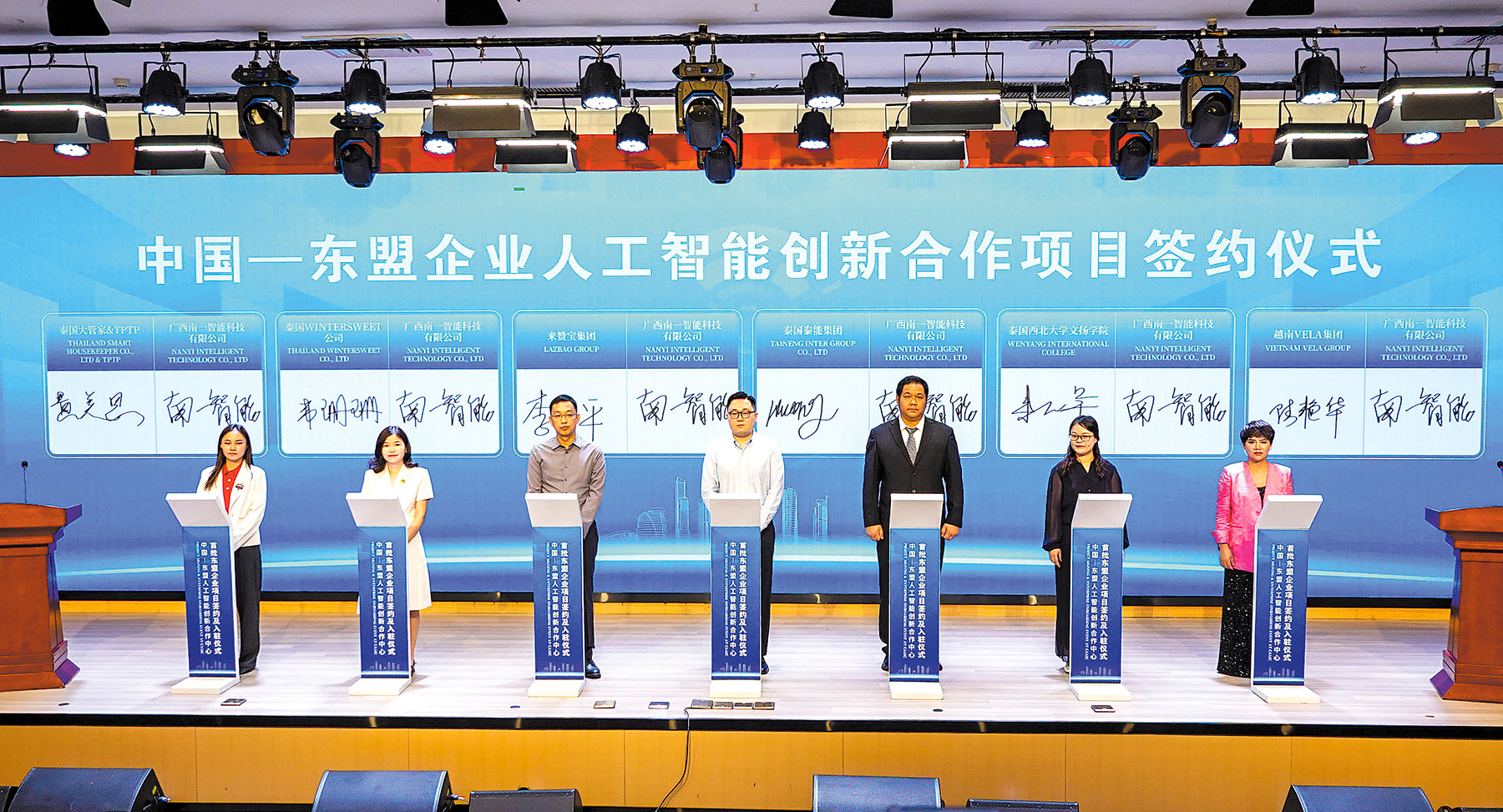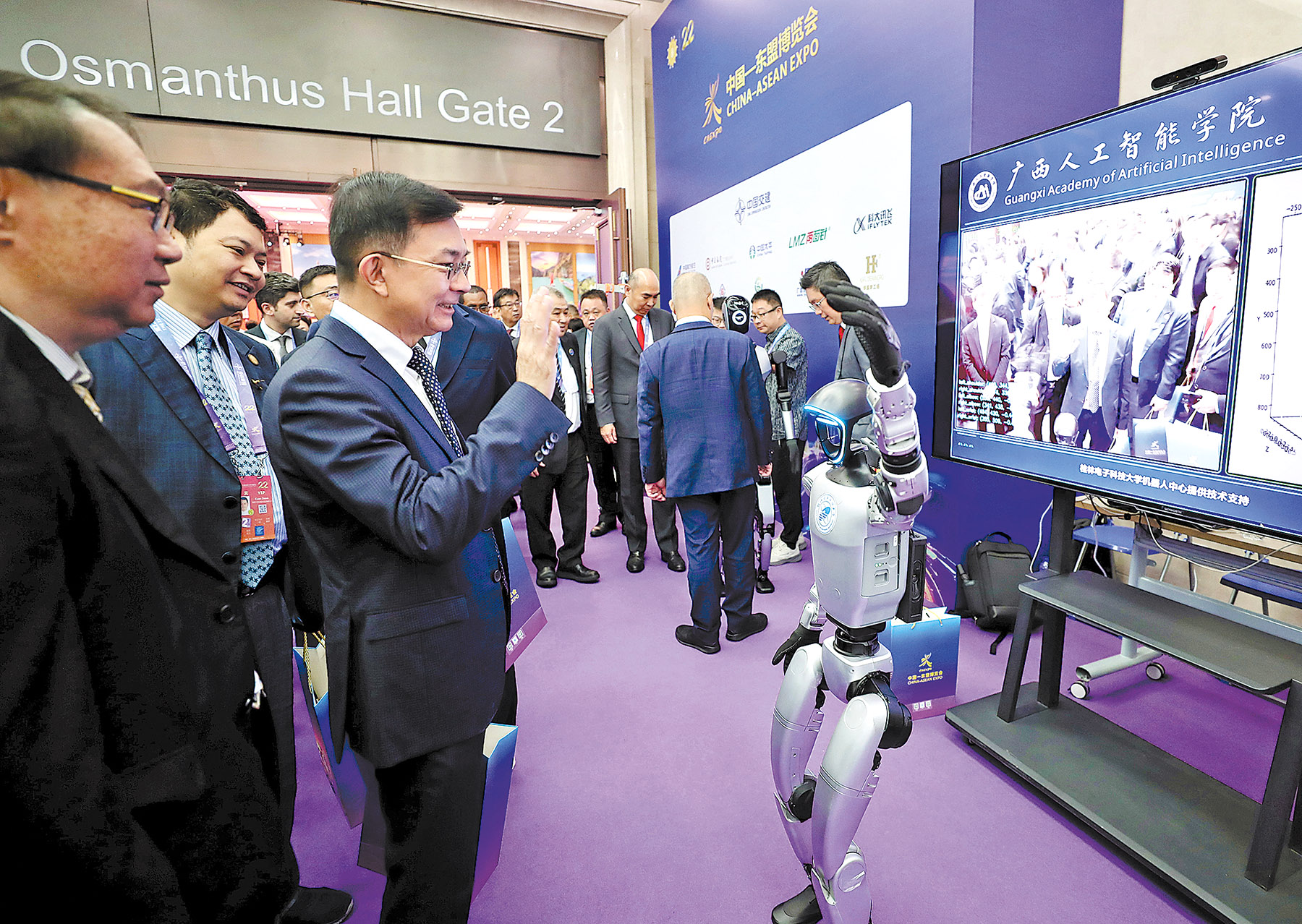Strategic advantages leveraged to propel China-ASEAN cooperation

It started as a novel technology contest, but the "AI Super League" has quickly developed into a leading platform for greater China-ASEAN cooperation on artificial intelligence, according to industry chiefs and officials.
The concept has also provided South China's Guangxi Zhuang autonomous region with the opportunity to shore up its geographical advantage as a bridge to member states of the Association of Southeast Asian Nations.
The "AI for All: China-ASEAN" initiative, or "AI Super League", organized by the Guangxi regional government, started in July.
READ MORE: Over 500 economic, trade deals inked at China-ASEAN Expo
It has drawn an impressive lineup of more than 3,300 teams from across China's 31 provincial-level regions and ASEAN member states. A total of 329 teams from ASEAN are competing in nine categories, ranging from cross-border e-commerce and cultural tourism to automotive innovation and modern agriculture.

Lu Xinning, a member of the Standing Committee of the Communist Party of China Guangxi Committee and vice governor of the Guangxi People's Government, said the league has evolved beyond a mere technology contest.
With no entry barriers, the competition has built an innovation community reaching from Guangxi to the rest of China and extending across the region. "This marks a shift in China-ASEAN cooperation from traditional domains to the digital sphere, paving the way for more inclusive development of artificial intelligence," Lu said.
From its inception, the AI Super League has actively engaged ASEAN enterprises and encouraged the formation of joint teams involving Chinese and ASEAN companies, fostering deeper industrial integration, she said.
With the theme, "AI Guangxi, AI China, AI ASEAN", the event runs from July to November and has drawn top domestic and international enterprises, research teams, university students, and individual developers.
ASEAN-specific application scenarios are being explored and AI enterprises targeting the ASEAN market supported. Deep integration of AI technology with the real economy is also being promoted.

Innovation inroads
On Sept 6, Nanning, the capital of the autonomous region, hosted the finals of the Artificial Intelligence+Automotive Innovation Competition, which attracted teams from across China as well as Southeast Asian nations.
Under the theme "Intelligence Drives the Future: Empowering the New Era of Automotive Development with AI", the event showcased how cutting-edge AI is reshaping the automotive industry. Twenty competing teams were eventually selected for a road show to highlight their innovations.
"I was deeply impressed," said Phoy Yong Hao, chief operating officer of ServAuto Sdn Bhd, a Malaysian auto service company. "It was my first time in China, and witnessing the country's AI trends and advancements made me realize that China's AI development has already reached a relatively mature stage."
AI streamlines and accelerates industry development, providing the best solutions for both customers and brick-and-mortar stores, he said. "The competition reveals that the prospects for China-ASEAN AI cooperation and the automotive trade are truly exciting," Phoy said.
Liu Kainan, executive president of Guangxi Minzu University's Xiangsihu college, said the goals of the automotive innovation competition were to translate cutting-edge technologies into real application scenarios in Guangxi, lower the entry barriers, and empower local small and medium-sized enterprises.
"We also hope that the initiative will allow students to engage directly with advanced application environments, which will be of immense value not only for Guangxi's future AI-driven industrial integration but also for equipping its students with forward-looking career opportunities," he said.
Several Chinese university teams made the final of the competition, according to a media release.

Strategic advantage
In recent years, Guangxi has stepped up efforts to position itself as a hub for China-ASEAN AI innovation and application.
A cross-border industrial ecosystem is rapidly taking shape, with R&D centers in major cities including Beijing, Shanghai, and Guangzhou, Guangdong province.
As China's strategic bridge to ASEAN, Guangxi has emerged as a vital testing ground and gateway for corporate technological innovation.
Comprehensive cooperation with the region has become an integral part of many enterprises' internationalization strategies, said Liu Qingfeng, chairman of iFLYTEK, a Chinese AI and intelligent speech giant.
The company has developed an ASEAN edition of the iFLYREC multilingual meeting system, which covers all 10 ASEAN languages.
The system is designed for daily office use, international business meetings and multilingual training to overcome language barriers, enhance cross-border collaboration, and streamline information processing.
In the education sector, the company's AI Chinese-learning platform for ASEAN countries is helping make language lessons "smarter" and more engaging. It aids teachers in faster preparation of lessons, improves interaction with students, and brings Chinese learning to more classrooms across ASEAN.
"Our collaboration with ASEAN is not just about exporting AI tools, but about building a shared ecosystem for innovation and growth," Liu said.
"By leveraging Guangxi's unique geographical advantages, we will draw on iFLYTEK's deep expertise in technology, products, and industrial applications to systematically empower ASEAN. Together with Guangxi, we will build a new high ground for AI cooperation rooted in Guangxi, serving ASEAN, and reaching the world," he added.

Wider solutions
In March 2025, Guangxi unveiled its AI + Manufacturing Action Plan (2025-2027), which calls for Nanning to establish the China-ASEAN Artificial Intelligence Collaborative Innovation Center, or CAAIC.
The plan envisions a regional innovation and application hub with Nanning at its core, backed by coordinated support from other cities, to accelerate the supply of AI software and smart terminal products.
Liu said China's AI industry is advancing at a rapid pace, and breaking the long-standing monopolies of a few countries in core AI technologies.
"By offering both a 'Chinese solution' and 'Chinese wisdom', China is contributing to global AI development while promoting the inclusive and diverse application of this transformative technology," he said. "Through the joint establishment of the CAAIC, our goal is to transform the Guangxi experience into an ASEAN solution."
The CAAIC's chief scientific officer, Guo Sha, said Guangxi has special advantages in advancing AI development and deepening coordination with ASEAN countries.
"Guangxi's drive to accelerate AI development comes against the backdrop of China's broader push for self-reliance, application-driven innovation, and the safe, orderly growth of the AI sector in a way that is both equitable and beneficial," he said.
Guangxi, with its geographical advantages, is well-positioned to seize opportunities by harnessing AI to drive growth across a wide range of industries, he added.
"Guangxi's geographical proximity and similar climatic conditions with ASEAN countries make it an ideal partner," Guo said.
"AI-powered agricultural technologies developed in Guangxi can be readily applied by farmers across the region, helping them control pests and diseases, raise crop yields, and ultimately improve their livelihoods."

The region is also actively promoting joint AI talent development with ASEAN countries. "The CAAIC has launched collaborative projects with universities in Laos and Thailand, hosting students from these countries to cultivate their own AI expertise," Guo said.
In addition, the center is partnering with ASEAN countries to promote sound and fair AI governance, he said.
"Data lies at the heart of AI, and in China-ASEAN collaboration, cross-border data flows remain a crucial issue," Guo said.
"Such connectivity brings with it challenges related to data security, privacy protection, and the ethical use of large AI models — all core concerns for the future of AI."
ALSO READ: Building AI bridges across regions
To address these issues, the center is engaging with international research projects on AI ethics and participating in global cooperation efforts. The aim, officials said, is to ensure that when serving ASEAN and other Global South nations, collaboration is carried out through credible institutions that adhere to internationally recognized standards.
"These initiatives are set to position the CAAIC as a key platform for regional cooperation and shared development, creating fresh opportunities and momentum for collaboration in AI across nations," said Chang Liang, deputy director of Guangxi Big Data Development Bureau.
"With 'AI for all', we will build the technology that benefits all, and make sure the AI transformation empowers all countries," he said.
Contact the writers at liujianqiao@chinadaily.com.cn


